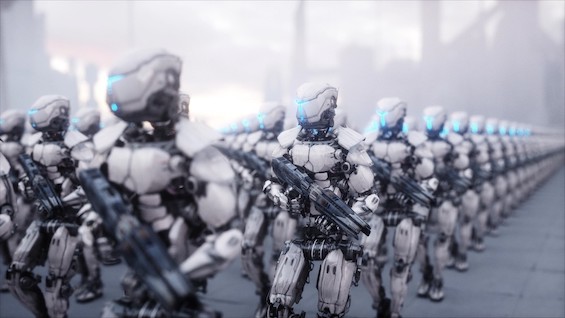
Visions of future warfare abound with horror stories about robot soldiers. Ranks of Star Wars stormtroopers march through our eyes as we think the unthinkable of war conducted by proxy, with human operators located at great distance from the front lines like the men and women who pilot Reaper and Predator drones from a secure location in the Nevada desert. Joe Haldeman, author of The Forever War, the most storied war novel in science fiction history, offers a somewhat different take in Forever Peace, a sequel that’s not a sequel to his multiple award-winning novel. In his tale of automated mid-twenty-first century war, robots do go on the front lines, but their human operators are bodily and mentally integrated through brain-computer interface technology.
Estimated reading time: 6 minutes
Robots operated remotely through brain-computer interface
In Haldeman’s seemingly prescient look at the future of the US military, robot “soldierboys” and “flyboys” are operated by “mechanics” with high IQs and often advanced degrees. Just 6,000 of them suffice for the Alliance to wage war worldwide. A mechanic is “jacked in” both to a robot itself and, through a digital network, to the other nine men and women in a platoon. They “live in each other’s bodies for nine days,” still basically functional after all that time because “their bodies had been exercised constantly and adjusted for fatigue poisons.” In any case, “mechanics aren’t in any physical danger, deep inside the Operations bunker in Portobello” in Panama. There in the US Army’s hemispheric base, they’re waging war against the “rebel” nations of Latin America which are allied with the African-led insurgency known as the Ngumi.
Forever Peace (Forever War Trilogy #2) by Joe Haldeman (1997) 360 pages ★★★★★
Winner of the Hugo and Nebula Awards for Best Novel

Haves versus have-nots
“The enemy Ngumi comprised a loose alliance of dozens of ‘rebel’ forces, fifty-four this year. In all enemy countries there was a legitimate government that cooperated with the Alliance, but it was no secret that that few of those governments were supported by a majority of their constituents. It was partly an economic war, the ‘haves’ with their automation-driven economies versus the ‘have-nots,’ who were not born into automatic prosperity. It was partly a race war, the blacks and browns and some yellows versus the whites and some other yellows. . . And of course it was an ideological war for some—the defenders of democracy versus the rebel strong-arm charismatic leaders. Or the capitalist land-grabbers versus the protectors of the people, take your pick.”
Why the military won’t use autonomous robots
Haldeman reveals the flaw in reasoning that undermines the fears we have of robot soldiers. “They didn’t use armed robots, for several reasons. One was that they could be captured and used against you; if the enemy could capture a soldierboy they would just have an expensive piece of junk. . . Another problem with robots was autonomy: the machine has to be able to function on its own if communications are cut off. The image, as well as the reality, of a heavily armed machine making spot combat decisions was not something any army wanted to deal with.”
These Remote Combat Units, unlike anything possessed by the rebels, are the principal means by which the United States and its Allies wage war worldwide. “Fewer than a dozen nuclear weapons, small ones, had been used in twelve years of war.” A single soldierboy had the capacity to destroy a small city unaided.
A future of unlimited abundance—for some
The future technology Haldeman portrays is centered on an invention called the “nanoforge.” With unlimited power supplied by “warm fusion,” the nanoforge is an ultrasophisticated 3-D printer that can produce virtually anything from food to housing to transportation, given the necessary raw ingredients. With such machines under the exclusive control of the United States Government, the Universal Welfare State has become possible—but only in the United States and its Allies.
The upshot is the “the whole idea of money had changed with the nanoforges.” Most people had once worked for a living. No longer. “At least in the ‘first world,’ most jobs having to do with production and distribution of goods were obsolete or quaint. Nanotechnology had given us the nanoforge: ask it for a house, and then put it near a supply of sand and water. Come back tomorrow with your moving van. Ask it for a car, a book, a nail file. Before long, of course, you didn’t have to ask it; it knew what people wanted, and how many people there were.”
The nanoforge changed the pursuit of ‘Big Science,’” too. Sergeant Julian Class, the platoon leader who is the novel’s protagonist, is a physicist who works in times away from combat on the staff of the massive Jupiter Project. With virtually unlimited power available, it involves “the biggest machine ever built, by several orders of magnitude.” The project’s objective is to recreate the Big Bang and thus learn in great detail how the universe came into being.
Haldeman adroitly weaves together two parallel plotlines, one involving Julian’s war with robot soldiers in Costa Rica, the other, the work he is doing on the Jupiter Project. Eventually the two converge . . . and the result, we’re led to believe, is “forever peace.”
About the author

Joe Haldeman was born in Oklahoma City in 1943. He received a BS degree in Physics and Astronomy from the University of Maryland in 1967 and was immediately drafted into the United States Army. He served as a combat engineer in the Vietnam War and was wounded in combat. Soon afterward, he began writing about his war experience and received an MFA in Creative Writing from the Iowa Writers’ Workshop. Haldeman won numerous Hugo and Nebula Awards for his novels, including both The Forever War and Forever Peace. He has also received the coveted Grand Master Award from the Science Fiction Writers of America and inducted into the Science Fiction Hall of Fame.
Forever Peace is often considered part of the Forever War series, but it is not a sequel to the eponymous 1975 novel, as Haldeman notes in a “caveat lector” at the outset. “From the author’s point of view,” he writes, it’s an effort to examine “some of that novel’s problems from an angle that didn’t exist twenty years ago.”
For related reading
You’ll find this book in good company at Great military science fiction.
I’ve also reviewed the author’s The Forever War – Forever War Trilogy #1 (This classic science fiction war novel won both the Hugo and Nebula Awards).
For more good reading, check out:
- These novels won both Hugo and Nebula Awards
- Great war novels reviewed here
- The ultimate guide to the all-time best science fiction novels
- 10 top science fiction novels
- Seven new science fiction authors worth reading
- The top 10 dystopian novels reviewed here
And you can always find my most popular reviews, and the most recent ones, on the Home Page.


























